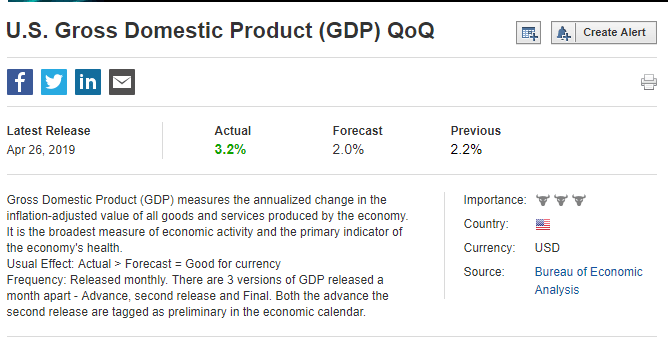
- All Instrument Types
- Indices
- Equities
- ETFs
- Funds
- Commodities
- Currencies
- Crypto
- Bonds
- Certificates
Please try another search

Which stocks will surge next?
Gross Domestic Product (GDP)
What Is Gross Domestic Product?
Gross Domestic Product, often referred to simply via the acronym GDP, measures the economic size of a country by calculating the monetary value of all the finished goods and services created within that country for a given period, most often annually or quarterly. The result of this calculation is the nominal GDP, but to compare GDPs from different years, the nominal GDP must be adjusted for inflation using a price deflator, resulting in real GDP.
Generally, economic cycle analysis considers a country healthy if real GDP is increasing--or expanding. Its economy is said to be booming when the increase is greater than the trend rate.
A country with a real GDP that is decreasing--or contracting--is considered to be in a recession when real GDP falls for two consecutive quarters. A depression occurs when real GDP falls by 10% or more from peak to trough.
How is the GDP Metric Used?
Economists use the GDP to compare the size, health, and trends of national economies; policymakers use it to evaluate and adjust economic programs under their control, and investors use GDP as a general indication of risk and earnings potential within a country or group of countries. Similar to Market Capitalization for a company’s stock, GDP gives an investor a general idea about the growth, risk, and volatility that can be expected when investing in an asset or assets within a country.
GDP is used internationally to compare the size and power of one economy to another. Individual national GDPs must be converted to a standard unit by using either a foreign exchange market rate or a purchasing power parity rate. The latter is usually based on the United States dollar.
Comparing GDPs establishes the largest and most significant economies who typically set world trade policy, e.g., the US, China, Japan, Germany.
How is GDP Calculated?
For the purpose of calculating GDP, “finished goods and services” includes consumption, business investment, government spending, exports, and imports. The three methods of calculating GDP include the expenditure approach, the output approach, and the income approach.
Each method yields the same value, much the same way that the price of an asset is the same for both the buyer and the seller.
The formula for the expenditure approach is:
Nominal GDP = C + I + G + (X- M)
- C = Consumption, I = Investment, G = Government Spending, X = Exports, M = Imports
The formula for the GDP price deflator is:
Deflator = (Nominal GDP/Real GDP) x 100
The formula for real GDP is:
R = N/D
R = Real GDP, N = Nominal GDP, D = Deflator
Finding GDP Information on Investing.com
The worldwide Economic Calendar is also available via the News section under the Economic Calendar. The calendar can be customized and filtered by keyword, country, the significance of the announcements plus a variety of other parameters.

Individual country history is available by clicking on the hyperlink of each country’s GDP listing, for a more granular view of recent and previous, e.g., the US GDP page is https://www.investing.com/economic-calendar/gdp-375.





